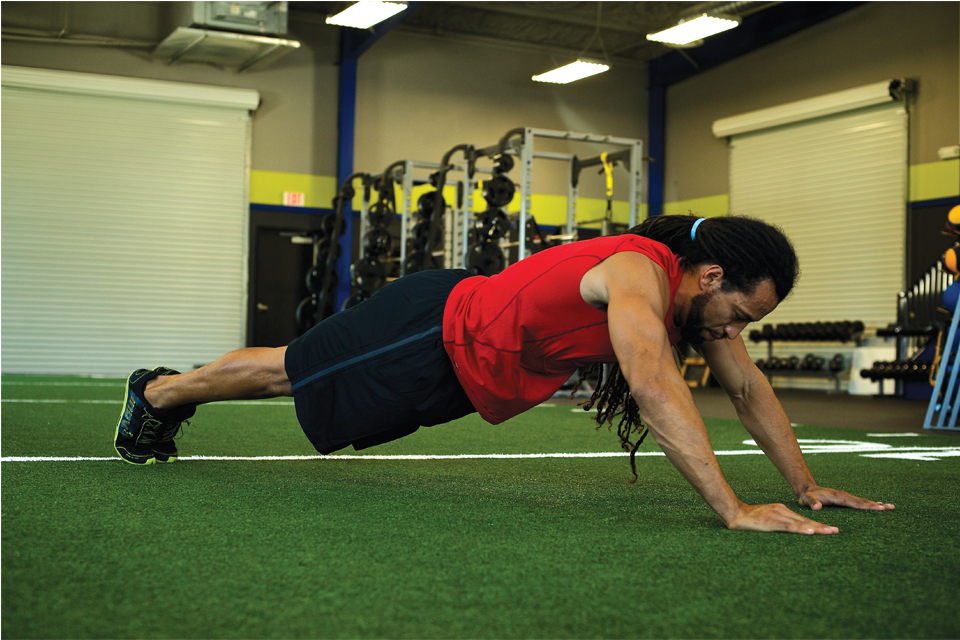Functional Movement Screening Means Smarter and Harder Training

The Functional Movement Screen (FMS) has been defined by fitness professionals as “a simple system of evaluating basic movement abilities.” Stating it like that admittedly seems a bit stale, especially during a time when it’s popular to get big shout-outs for posting AMRAPs (“as many reps as possible”) on Facebook.
In truth, this seemingly boring, almost clinical-sounding, screening tool is one of the emerging gems that is changing the game for sports and fitness athletes alike. It is providing the competitive edge for NFL teams such as the Seattle Seahawks, and it’s keeping a 45-year-old fitness client from missing a workout for an entire year.
The philosophy behind FMS has truly changed the game for many training professionals. So, what is FMS and why use it? This question is perhaps best answered by the simple mantra that Gray Cook, co-creator of FMS, has shared with professionals around the world: “Move well. Move often.”
Cook’s words speak volumes because he identifies the fact that many well-intentioned people in the fitness and sports industry are getting things a little backwards. The focus is usually “move often (first), then try to move well.” The thinking is that, even though we may be moving poorly, our bodies will figure it out if we just pile on the reps and intensity in the vein of “getting fit.”
Well, here’s the reality check: By loading physical conditioning on top of dysfunctional or poor movement, we further force the body to compensate and redirect energy and efforts into more of a survival mode. Not only does this hinder progress, it also increases risk for injury. It can also be very defeating to overcome emotional steps and challenges and commit to a new training program only to become injured early in the process.
Cook’s words amplify that, when we “move well” before undertaking higher intensity physical conditioning, our bodies are able to adapt to the training and become more durable. Although there are never any guarantees, reducing the risks of injury and building confidence in the ability to move can yield impressive results at all levels of performance.
Movement screening, such as the FMS, uses seven foundational movement patterns to determine an acceptable movement baseline to apply training. If there is a movement pattern that cannot be performed, the FMS professional will use that information to very specifically streamline corrective strategies and adjust the training program to integrate them. If pain occurs during a movement, the athlete will be referred to a medical professional in order to quickly address the issue and not further delay progress.
The Seven Tests Used in the FMS
Deep Squat, Hurdle Step, In-Line Lunge, Shoulder Mobility, Asymmetrical Straight-Leg Raise, Trunk Stability Push-Up, Rotary Stability.
The FMS is a tool for exercise selection and adjusting training protocols to streamline success. It's designed to take a look at mobility, motor control (stability), and full functional movement patterns in three key stances. Exercises associated with these key areas that contribute to good movement ability can be targeted as needed rather than randomly lumped into a preventative or functional training program.
As a strength and conditioning specialist, I have worked with all levels of athletes and fitness clients. Since implementing the FMS, I have discovered that identifying areas that need specific corrective attention—as well as determining where there's a green light to train more aggressively—provides the best overall outcomes and success. FMS allows me to effectively screen for key information related to movements and make smart choices in exercises, training methods, and progressive programming.
To my fellow fitness and strength and conditioning professionals, one of the most powerful things I have discovered is that the FMS allows me to re-test my work to see if I am making the best choices and having a positive impact on the movement baseline. That is a powerful checks-and-balance system in order for the athlete to have the most effective response to a training stimulus.
Athletic endeavors or reaching for a big personal fitness goal highlight the need to push the body to the edge of its ability, recover, and do it all over again. This is what “the competitive edge” really represents. Cook and co-founder Lee Burton continue to share their knowledge all over the world so that, as a fitness and sports community, we know how to set a baseline for movement and affectively apply a training philosophy or method of choice.
To find out more information or locate an FMS certified professional in the Austin area, visit functionalmovement.com.






